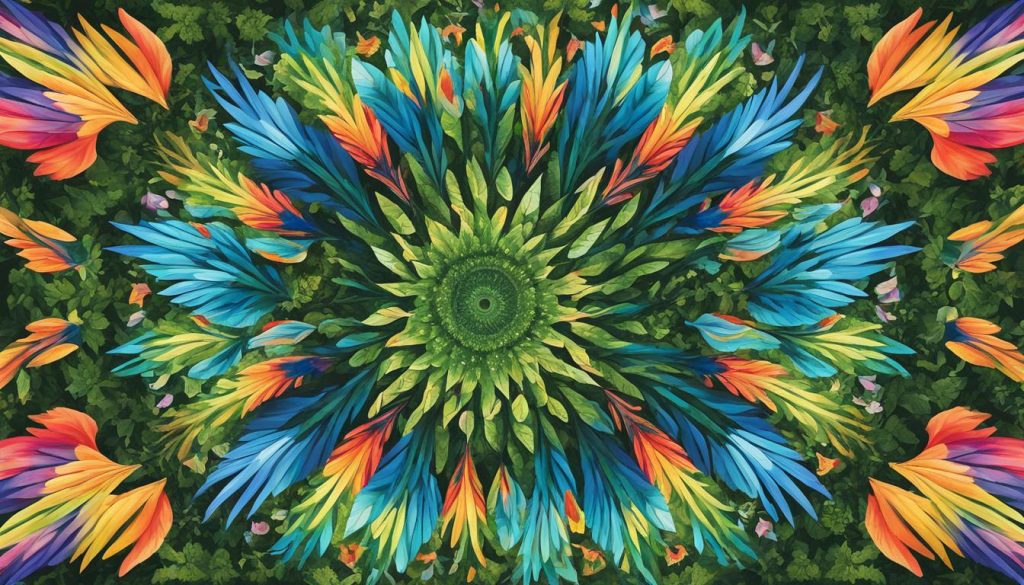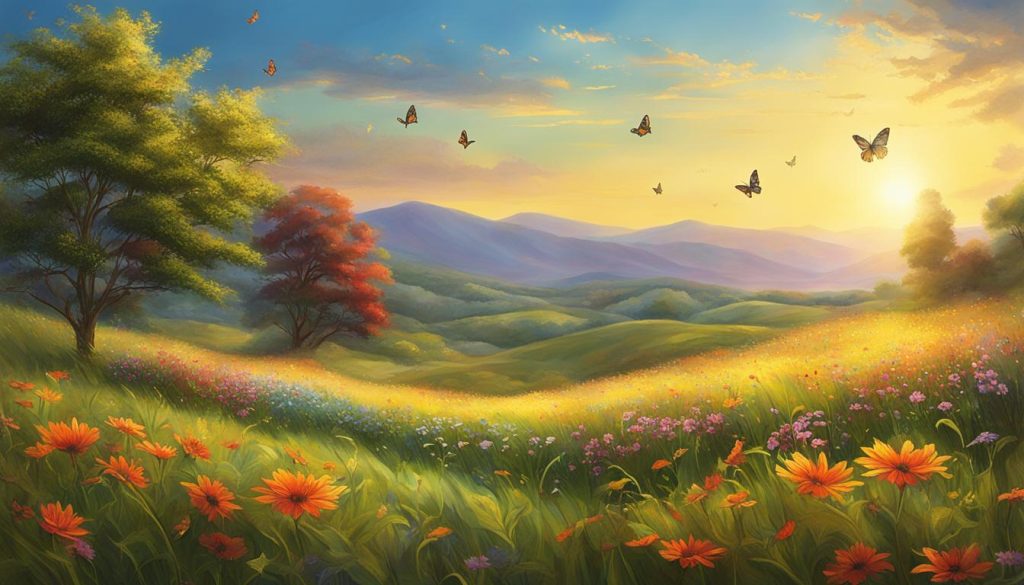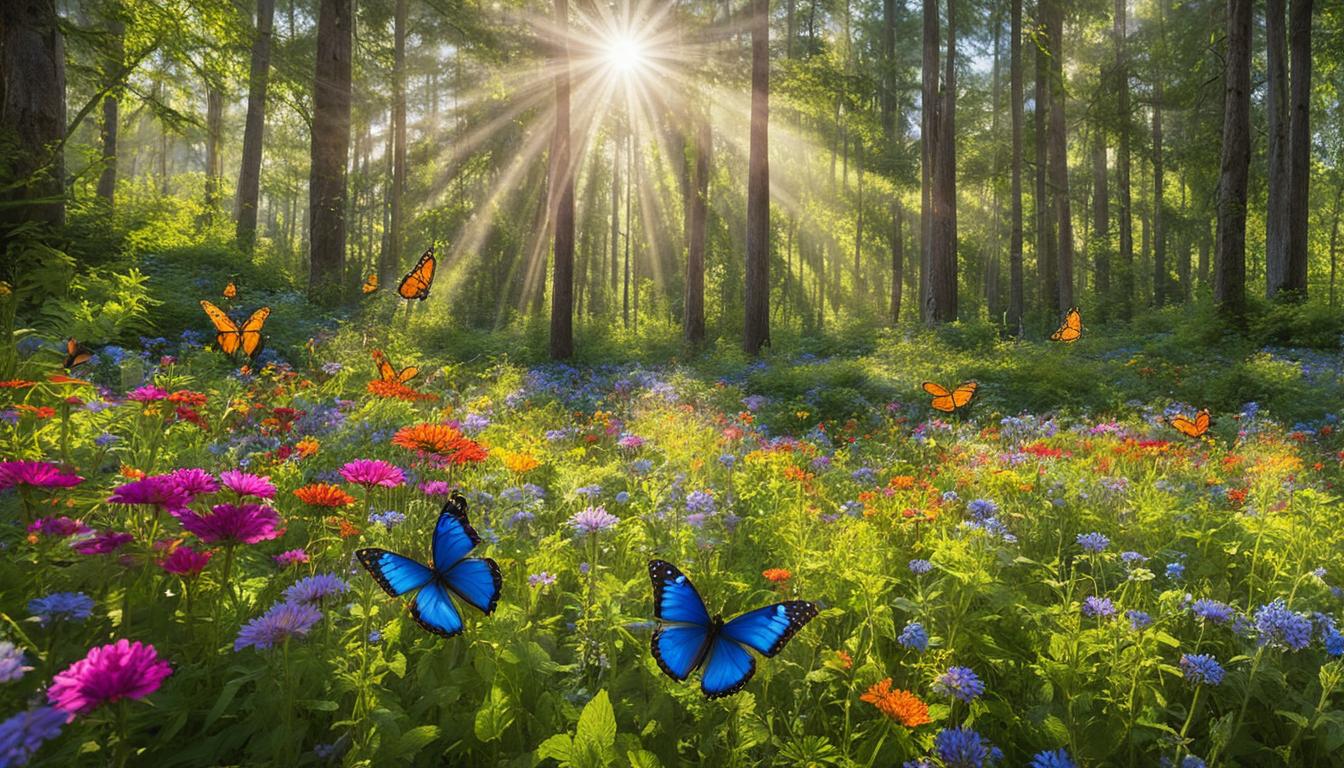Experience the breathtaking beauty of butterflies in their natural habitat through the lens of renowned photographer Thomas Marent. In his captivating book “Rainforest,” Marent takes readers on a visual journey spanning 16 years, capturing the vibrant colors and intricate details of rainforest life.
Marent’s photographs transport us to lush rainforest ecosystems, where butterflies gracefully flutter among exotic foliage and delicate flowers. These stunning images offer a glimpse into the extraordinary diversity and complexity of these fragile habitats.
Published in 2006, “Rainforest” has become an international sensation, available in 15 languages. The book’s accompanying CD features the soothing sounds of the rainforest, further immersing readers in the enchanting world of butterflies.
Key Takeaways:
- Thomas Marent’s book “Rainforest” showcases his mesmerizing photographs of butterflies in their natural habitat.
- Marent spent 16 years capturing the beauty and complexity of rainforests, including butterflies, reptiles, birds, and mammals.
- “Rainforest” is available in 15 languages and includes a CD with the natural sounds of the rainforest.
The Decline of Butterflies and Conservation Efforts
The Monarch butterfly, known for its vibrant colors, is facing a decline in population due to habitat destruction, chemical use, and the lack of milkweed, a vital plant for their survival.
Conservation efforts are being made to protect these delicate creatures. One approach is to plant milkweed and wildflowers along roadsides and right of ways. These plants provide essential sustenance for the Monarch butterfly and support their life cycle.
Individuals can also contribute to butterfly conservation by planting milkweed and creating butterfly-friendly habitats in their own yards. By providing a suitable environment with food sources and shelter, you can play a role in preserving the Monarch butterfly population.
The Importance of Milkweed
Milkweed is crucial for the survival of Monarch butterflies as it is the only plant on which they lay their eggs and is a vital food source for their caterpillars.
Without sufficient milkweed, Monarch butterflies struggle to find suitable breeding grounds and sustain their populations. Actions taken to preserve milkweed habitats directly impact the conservation and survival of these beautiful butterflies.
Migration and Its Challenges
Every year, millions of Monarch butterflies undertake an incredible journey from North America to Mexico, spanning thousands of miles.
During their migration, Monarch butterflies face numerous obstacles, including habitat loss, extreme weather conditions, and exposure to pesticides. These challenges further contribute to their declining population.
Conservation efforts aim to address these challenges by protecting and restoring critical habitats along the migration routes, providing safe resting places and food sources for the migrating Monarch butterflies.
The Impact of Conservation
Conservation efforts are not only crucial for the survival of Monarch butterflies but also have broader ecological implications. By protecting butterflies and their habitats, we contribute to the overall health and diversity of ecosystems.
By taking action to preserve milkweed habitats and creating butterfly-friendly environments, we can make a significant difference in safeguarding the Monarch butterfly population and promoting biodiversity conservation.
Photography Techniques and Capturing Butterflies in Flight
Wildlife photographer Andrew Fusek Peters has mastered the art of capturing breathtaking images of butterflies in flight. Through his innovative photography techniques, he offers a unique glimpse into the world of these delicate creatures. With a deep understanding of their behavior and natural habitat, Peters has become a leading authority in butterfly photography.
One of Peters’ notable techniques is the use of a high-speed photography system. This technology allows him to capture multiple photos in rapid succession as a butterfly takes off, resulting in a mesmerizing “time travel” effect. By freezing the precise moments of flight, Peters is able to showcase the intensity and intimacy of these extraordinary creatures.
To achieve the perfect shot, Peters takes thousands of photographs to capture a single sequence of a butterfly in flight. This level of dedication and attention to detail demonstrates his commitment to capturing the true essence and beauty of these elusive creatures.

Andrew Fusek Peters: A Glimpse into His Work
“Butterflies possess an ethereal grace that is truly captivating. Through my photography, I seek to share their delicate beauty and raise awareness about the importance of conserving their natural habitats. Each image tells a story, inviting viewers to appreciate the fragile intricacy of the natural world.”
Peters’ illustrious photography career has earned him recognition and praise. His work has been featured in press agencies and published in numerous books, spreading awareness about butterflies and inspiring others to appreciate and protect these remarkable creatures.
Photography Techniques of Andrew Fusek Peters
| Technique | Description |
|---|---|
| High-Speed Photography | Utilizes a high-speed photography system to capture multiple photos as butterflies take flight, creating a time travel effect. |
| Dedication to Detail | Takes thousands of shots to capture one sequence of a butterfly in flight, ensuring the perfect portrayal of their grace and beauty. |
| Understanding of Behavior | Deep knowledge of butterfly behavior helps in capturing their natural movements and interactions, resulting in authentic and engaging photographs. |
Andrew Fusek Peters’ stunning photographs of butterflies in flight serve as a testament to their delicate beauty and the importance of preserving their natural habitats. Through his work, he has not only inspired fellow photographers but has also contributed to raising awareness about butterfly conservation.
The Impact of Photography on Mental Health
| Benefits of Photography on Mental Health | Examples |
|---|---|
| 1. Stress Relief | Connecting with nature through photography can provide a calming and therapeutic effect, reducing stress and anxiety levels. |
| 2. Mindfulness | Engaging in photography encourages mindfulness, allowing individuals to be present in the moment and focus on the beauty around them. |
| 3. Emotional Expression | Photography provides a creative outlet for expressing emotions, allowing individuals to capture and convey their thoughts and feelings visually. |
| 4. Self-Reflection | Photography enables self-reflection, as individuals explore their surroundings and capture images that resonate with their inner experiences. |
Photography, particularly nature photography, has shown remarkable benefits for mental health. Andrew Fusek Peters, a renowned wildlife photographer, found solace and healing through his passion for capturing the beauty of nature. During a challenging period in his life, Peters turned to photography as a means of finding emotional and mental relief.
Being in nature and immersing himself in the process of taking photographs provided Peters with a sense of joy and peace. Through the lens of his camera, he discovered a deeper connection with the natural world, allowing him to escape from the stressors of everyday life. The act of photographing not only allowed him to appreciate the beauty around him, but it also served as a form of meditation, allowing him to be fully present in the moment.
Studies have shown that spending time in nature and engaging in activities such as photography can have a positive impact on mental well-being. The combination of being in a natural environment and focusing on capturing its essence through photography has proven to be a powerful tool for stress relief and relaxation.
“Photography helped me find solace and healing during a difficult time. The process of exploring nature and capturing its beauty allowed me to immerse myself in the present moment and forget about my worries. It was a form of therapy that brought me joy and peace.” – Andrew Fusek Peters
Photography provides a unique outlet for emotional expression. Through the lens, individuals can capture and convey their thoughts, feelings, and experiences. This form of visual storytelling enables self-reflection, as photographers explore their surroundings and immortalize moments that resonate with their innermost thoughts and emotions.
By engaging in nature photography, individuals can create a space for self-expression and self-discovery. Whether it’s capturing the grandeur of a landscape, the intricate details of a flower, or the fleeting moments of wildlife, each photograph becomes a reflection of the photographer’s perspective and inner world. This process fosters a deeper understanding of oneself and promotes personal growth.
Photography also promotes mindfulness – the practice of being fully present in the moment. When individuals focus on capturing a photograph, they become attuned to the details, colors, and shapes in their surroundings. This heightened awareness cultivates a sense of mindfulness, allowing photographers to appreciate the beauty and intricacies of the natural world.

Engaging in photography as a hobby or creative pursuit can provide a sense of purpose and fulfillment. It allows individuals to connect with the world around them, find beauty in the ordinary, and create something unique. The combination of nature, creativity, and self-expression makes photography a powerful tool for improving mental well-being.
Conclusion
Butterflies in their natural habitat are not only a subject of fascination for photographers but also play a vital role in the ecosystem. The efforts of photographers like Thomas Marent and Andrew Fusek Peters have beautifully showcased the stunning beauty and importance of butterflies, raising awareness about their conservation needs.
Furthermore, engaging in nature photography, particularly capturing the delicate flight of butterflies, can have a positive impact on mental well-being. Andrew Fusek Peters found solace and healing in nature photography during a challenging period in his life. Being in nature and capturing its beauty through photography provided him with a sense of joy and peace, ultimately improving his mental health.
By appreciating and protecting butterflies, we contribute to preserving the exquisite wonders of the natural world. Through both photography and conservation efforts, we can ensure the continued existence of these enchanting creatures while also nurturing our own mental well-being.
FAQ
What is Thomas Marent’s book “Rainforest” about?
Thomas Marent’s book “Rainforest” showcases his stunning photographs of butterflies in their natural habitat. It also features images of reptiles, birds, and mammals found in rainforests. Published in 2006, the book offers a glimpse into the beauty and complexity of rainforest life.
Why is the Monarch butterfly facing a decline in population?
The Monarch butterfly is facing a decline in population due to habitat destruction, chemical use, and the lack of milkweed, a vital plant for their survival. These factors have contributed to a decrease in their numbers.
What efforts are being made to protect the Monarch butterfly?
Conservation efforts for the Monarch butterfly include planting milkweed and wildflowers along roadsides and right of ways. Individuals can also contribute by creating butterfly-friendly habitats in their own yards.
How does wildlife photographer Andrew Fusek Peters capture images of butterflies in flight?
Wildlife photographer Andrew Fusek Peters uses a high-speed photography system to capture stunning images of butterflies in flight. He takes multiple photos as the butterfly takes off, creating a time travel effect. Peters takes thousands of shots to capture one sequence, showcasing the intensity and intimacy of these moments.
What impact does nature photography have on mental health?
Nature photography, including capturing images of butterflies, has been shown to have a positive impact on mental health. It can provide solace, healing, joy, and a sense of peace. Engaging with nature and photography can be a form of emotional and mental relief.






